 |
Movie Reviews
A Historic Lesson:
The Danger of the Compromise
For Greater Glory: The True Story of Cristiada reviewed by
Judith Mead & Marian Horvat
When For Greater Glory, the movie about the Cristero War of 1926-1929, was released in select theaters this June 2012, we were interested in seeing it. After reading some of the negative reviews in the secular press – it is too violent, too biased, too Catholic – we were even more inclined to think that it might be something good. In fact, it is.
Except on two principal points – a misinterpreted religious liberty and a misleading ending to be discussed further on – we can highly recommend this movie as one not to miss.
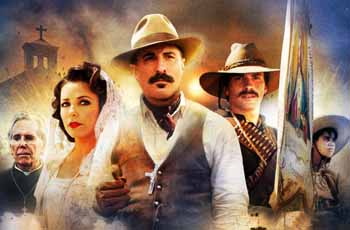
Left to right, Peter O'Toole, Eva Longoria, Andy Garcia, Oscar Isaac. Mauricio Kuri |
The all-star cast includes Andy Garcia, the agnostic General Enrique Gorostieta, solicited by the Cristeros to give military structure and efficiency to their fighting bands. He is convincing and, although in reality he probably never met the young Cristero martyr Jose Luis Sanchez del Rio, brilliantly played by Mauricio Kuri, one could consider their imaginary friendship as an acceptable artistic license, that is, a historic invention that did not adulterate the message of the movie. For, from the blood of martyrs comes conversions, and General Gorostieta – who was a Mason – did in fact convert. He admired the effect of faith on the men fighting under his orders and, in the end, he embraced the Catholic Faith and died heroically.
The only miscasting was Peter O’Toole as an elderly foreign priest, who supposedly turned the wayward José onto the road of piety. Here is a case of misplaced artistic license. In reality José was a pious boy formed by upright Catholic parents, as you can read here. O’Toole’s simpering affection for the young José seemed in very poor taste to us, given the present day pedophile crisis in the clergy. In addition, his gaze of terror in the face of death is unworthy of a Cristero martyr for the Faith.
A war against tolerance
Generally speaking, this is an accurate film on the Cristero War. It portrays a history that has either been purposely deleted or falsely told from the point of view of its Masonic victors. We have a friend in Mexico who affirmed that La Cristiada is simply skipped over in their history books since what happened in Mexico during those three years does not correspond to the government's revolutionary lies that the people were oppressed by the Church and wanted to be free from her iron fist.
In fact, this remarkable movement of Catholic resistance came primarily from the peasants and little people who loved the Church and wanted its pre-Revolution rights restored. They wanted the Catholic Church to baptize and educate their children, bury their dead and regulate their laws. They opposed the Masonic ideals of separation of Church and State, civil marriage and divorce, purely secular education, the expulsion of religious communities.
The Cristeros were actually against the modern notion of religious liberty based on tolerance: They vehemently opposed the program of President Plutarco Calles – an atheist and 32nd degree Mason – to bring Protestant sects from the U.S. into Mexico, as well as his attempt to start a national Patriotic Church. So great was their love for the Catholic Church that they took up arms to defend her. They were battling for the legitimate and singular rights of the one true Faith, professed only by the Catholic Church, and to extend the Kingdom of Christ over the entire secular society. It was a counter-revolutionary fight.
Consequently, the main defect of For Greater Glory is that it presents the Cristero War as a fight for religious liberty, probably to satisfy Hollywood demands and win the praise of a larger audience. But, ultimately, we are glad to report, it fails in this intended aim. When the viewers hear the rallying cry “Viva Cristo Rey” defiantly and triumphantly proclaimed by the Cristeros – even in the face of torture and death – they instinctively understand that these men were fighting against the systematic uprooting of the Catholic Faith and for the restoration of a Catholic society where Christ would reign as King. Perhaps this explains so many negative reviews by revolutionary organs of the media.
The violence issue
The movie portrays the cruel reality and barbarism of Calles’ attack on Mexican Catholics, but not in the sadistic way of so many modern movies for youth. Also, it is morally clean except for two inconvenient moral faux pas (a discussion between Gen. Gorostiesta and his wife in bed and young women from the Joan of Arc Brigades hiding bullet packs in their 1920s style undergarments). It is a shame that an R rating was slapped on this film, especially since this permits R-rated previews of blatantly immoral movies to be shown at the start.
Obviously, it is not for very young children, but youths in their teens would be well advised to see For Greater Glory. This is a film – rare in our days – that can inspire them to offer their lives for a Catholic ideal.
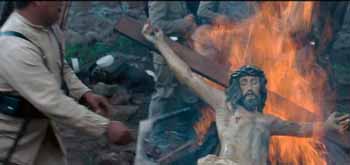
Federal troops burning the crucifix - a realistic scene |
In fact, director Dean Wright has noted that, regarding violence, many of the stories he heard of the Cristero War were actually much worse than what is portrayed in the film. Torture was systematically used by the government troops to prolong the suffering of Catholics and to persuade them to renounce their faith, since the threat of death did not move them.
So they were flayed and burned. They had their tongues cut out and their bones broken. They were quartered alive, hung up by their thumbs, electrocuted, scorched by blowlamps, racked and dragged behind a horse.
These and other gruesome crimes did not make it into the film, Wright said, “because while we tried to present the facts as they were, we didn’t want to overwhelm people."
Although we see the federales destroying churches and burning crucifixes, we do not hear about the officers who rode into churches on horseback and trampled the Hosts underfoot, used statues for target practice, and rallied their troops to the cry of “Long Live Satan!”
Objective anti-Catholic depiction
The movie opens in 1927, as the virulently anti-clerical and Masonic President Plutarco Calles determines to enforce the anti-clerical mandates of the 1917 Constitution.
Many of its provisions were designed to eliminate the Church as a force in the life of the nation: all elementary education became secular; Catholic schools and newspapers were shut down; seminaries and convents were seized and desecrated; monastic orders were outlawed; all public worship was prohibited outside churches; all Church property became State-owned; foreign priests were deported, and all Mexican priests had to register with the government and be subject to civil regulation; Church authorities were forbidden to comment on public affairs.
That such a degree of repression could occur in a country as Catholic as Mexico is sobering, to say the least. Mexico had been the base from which missionaries evangelized North and Central America. The Masons understood that to crush the Catholic Church, their Constitution of 1917 had to be applied.

The national boycott did not change Calles from his anti-Catholic position |
As the movie unfolds, we watch the resistance form under the at-first pacific leadership of the National League for the Defense of Religious Liberty (LNDLR), formed in 1925. In the fall of 1926 the League organized a nationwide boycott – abstaining from unnecessary consumption and not paying taxes – to protest the crackdown on the Church. When Archbishop Mora y del Rio told Catholics to resist the constitution as anti-religious, the government forces used his counsel as a pretext to raise the volume of attacks against the Church.
The Catholic Hierarchy countered with a drastic action – it suspended the administration of Sacraments throughout the country. As the resentment of Catholics reached a boiling point, bands of peasants began to organize clandestinely and take up arms against the government. La Cristiada – the Cristero War – was born.
Betrayal
Despite overwhelming odds, the Cristeros were able to force the Federal army to a stalemate by 1929. Taking over one rural village after another, the Cristeros even began to organize alternate governments in the territories they controlled.
Ultimately, Calles was compelled to negotiate a truce because of the success of the 50,000 Cristeros, who, united in their fight, were overthrowing the revolutionary regime. By 1929 it was not so difficult for Ambassador Dwight Morrow, effectively played by Bruce Greenwood, to convince Calles to enter into negotiations with Church authorities for the conflict to end.
The U.S. interest was oil, and to ensure ownership of the large Mexican oil fields, the Ambassador arranged for the Mexican government to purchase from the U.S. 10,000 Enfield rifles, ten million rounds of ammunition, and even aircraft – along with some American pilots.
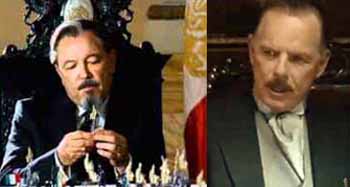
Calles, left, welcomes the arms and agreement brokered by Dwight Morrow |
In the film, we can see how Morrow took advantage of the Catholic Hierarchy’s willingness to compromise. Bishops Leopoldo Ruiz y Flores and Pascual Diaz de Tabasco returned to Mexico from exile to make a deal for the Church: The churches would re-open on the condition the Church authorities would give orders to the Cristeros to surrender their arms. All the Cristeros, including officers, would receive full amnesty.
In effect, the agreement (Los Arreglos) returned the situation to one similar to what had existed before the Cristeros fight, only this time the Church agreed to be subordinate to the State. The film also implies that Pope Pius XI stood behind the Bishops’ decision, which unfortunately he did.
In 1929 the Cristeros obediently laid down their arms. They did not fear to resist the Masonic Calles government, but, as loyal sons of the Church, they were helpless in the face of an order from the Hierarchy backed by the Holy See.
If the Cristero history is a long succession of miracles in battles and heroic gestures, it is also a woeful series of betrayals.
We have just mentioned the betrayal of the Mexican Catholic Hierarchy. But the Cristeros were also betrayed by the American Bishops, who were reluctant to give any sign of supporting an armed rebellion against a government recognized – and supported – by the United States. When the Cristeros sent a representative, René Capistran Garza, to raise funds for their cause among the American Prelates, he returned to Mexico almost empty-handed.
Even the Knights of Columbus (who, today, funded For Greater Glory) did not come through with the needed help. Although they raised $1 million, the Knights decided it should be used for refugees and relief work in the U.S., but not for the Cristero fight. Fr. Michael Kenny, a staunch supporter of the Cristero cause, found it ironic that "out of the million dollar fund raised by the Knights of Columbus for the Mexican cause, there was no assignment available to the men who were fighting for it." (1)
No happy ending
The closing scene shows the church bells ringing for the first time in three years after the Arreglos was signed, giving the idea that there was a happy ending to the Cristeros heroic resistance. The Sacraments were available and the Church seemed to be free again. This is far from the truth.
After the Cristeros put down their weapons, the two great bulwarks of conservatism in Mexico - the Church and the army - yielded to the authority of the Revolutionary State.
As for the promised amnesty, almost immediately the Cristeros were hunted down and coldly executed by the thousands.
As for the promised “liberty” for the Church, many churches remained closed, and priests practically vanished. Those few who were visible often were forced to compromise to operate “officially." In some areas teachers were required to take a public oath of atheism and to promise to teach against the Catholic Religion.
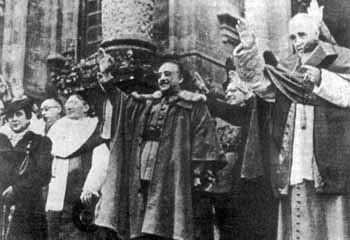
Mexican Prelates smile, content to be subordinate to the Masonic State |
The betrayal of the Cristero cause could not have been more complete on the part of the Mexican Hierarchy. Exasperated by the government persecution, thousands of Catholics rose again in a new Cristiada in 1935, But this time the Bishops condemned the new Cristeros, excommunicating any who took up arms. The Church had become a loyal supporter of the government, voicing their motto: "Better to take a little freedom than to resist."
It is impossible not to see the parallel to today's Vatican's betrayal of Catholics in China, often tortured and imprisoned by the Communist regime.
The very fact that almost no Americans and very few Mexicans know the history of the glorious Cristero War is proof of how complete the defeat was. Only in the 1980s were priests and nuns allowed to appear in public in clerical garb. To this day, government-issued textbooks in Mexico make no mention of that epic phase of history. This is the real ending of the Cristeros resistance, and it is not a good one.
It seems to us that there is a lesson to be learned from this sad ending for Catholics today who continue the resistance against the Progressivist Church. To lay down the fight for a few meager privileges is to lose the long-term battle. The way of compromise does not end in victory.
Viva Cristo Rey!
1. Matthew Redinger, "To Arouse and Inform": the Knights of Columbus and United States-Mexican Relations, 1924-1937, The Catholic Historical Review, vol. 88:3 2002, p. 490
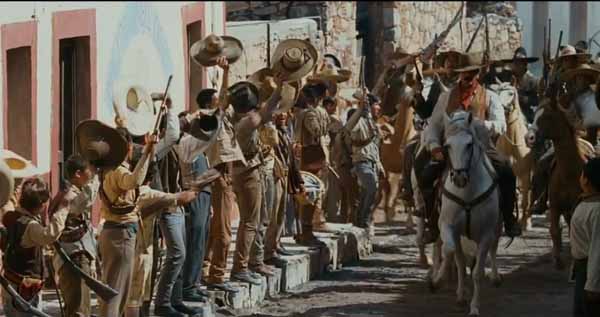
Cristeros cheer their general in For Greater Glory |

Posted June 27, 2012

Related Topics of Interest
 José Sánchez del Rio, Martyr for Christ the King José Sánchez del Rio, Martyr for Christ the King
 A Prayer of the Cristeros of Jalisco A Prayer of the Cristeros of Jalisco
 The Cristeros I: The Spaniards Land in Mexico The Cristeros I: The Spaniards Land in Mexico
 The Cristeros II: Long Live the Virgin of Guadalupe! The Cristeros II: Long Live the Virgin of Guadalupe!
 The Cristeros III: Hildalgo Raises the Standard of Revolt The Cristeros III: Hildalgo Raises the Standard of Revolt
 The Cabalgata of Christ the King The Cabalgata of Christ the King
 Benedict Delivers Chinese Underground Catholics to Communism Benedict Delivers Chinese Underground Catholics to Communism

Related Works of Interest
|
|
Movie Reviews | Home | Books | CDs | Search | Contact Us | Donate

© 2002- Tradition in Action, Inc. All Rights Reserved
|
 |
|